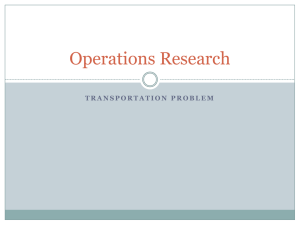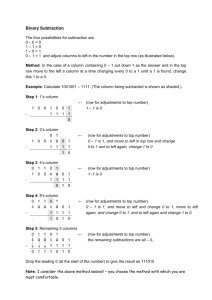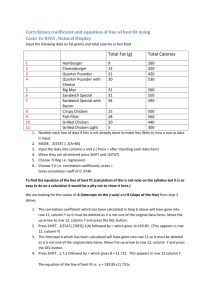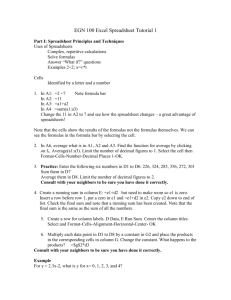Chap8 The Transportation and Assignment Problems
advertisement
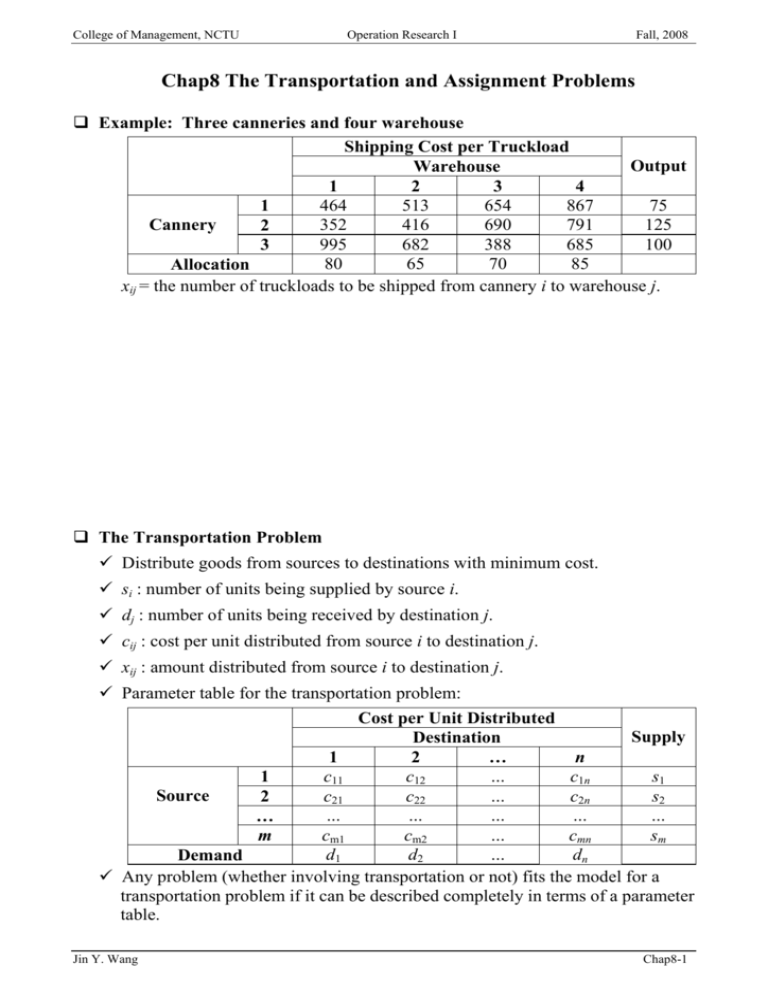
College of Management, NCTU Operation Research I Fall, 2008 Chap8 The Transportation and Assignment Problems Example: Three canneries and four warehouse Shipping Cost per Truckload Output Warehouse 1 2 3 4 464 513 654 867 75 1 Cannery 352 416 690 791 125 2 995 682 388 685 100 3 80 65 70 85 Allocation xij = the number of truckloads to be shipped from cannery i to warehouse j. The Transportation Problem 9 Distribute goods from sources to destinations with minimum cost. 9 si : number of units being supplied by source i. 9 dj : number of units being received by destination j. 9 cij : cost per unit distributed from source i to destination j. 9 xij : amount distributed from source i to destination j. 9 Parameter table for the transportation problem: Cost per Unit Distributed Supply Destination 1 2 … n c11 c12 c1n s1 … 1 Source c21 c22 c2n s2 … 2 … … … … … … cm1 cm2 sm … cmn m d1 d2 … dn Demand 9 Any problem (whether involving transportation or not) fits the model for a transportation problem if it can be described completely in terms of a parameter table. Jin Y. Wang Chap8-1 College of Management, NCTU Operation Research I Fall, 2008 9 Formulation m Min Z = n ∑∑ c i =1 j =1 n S.T. ∑x j =1 ij m ∑x i =1 ij ij xij = s i , for i = 1, 2, …, m = d j , for j = 1, 2, …, n xij ≥ 0 , for all i and j The feasible solutions property: A transportation problem will have feasible m solution if and only if n ∑s = ∑d i =1 i j =1 j . Integer solution property: For transportation problems where every si and dj has an integer value, all the basic variables in every basic feasible solution (including an optimal one) also have integer values. 9 We will discuss the reasoning after introducing the solution algorithm. Another example (production schedule) – with a dummy destination Scheduled Maximum Unit Cost Unit Cost Month Installations Production of Production of Storage 10 25 1.08 0.015 1 15 35 1.11 0.015 2 25 30 1.10 0.015 3 20 10 1.13 4 9 Tradition modeling way—xj be the number to be produced in month j. Jin Y. Wang Chap8-2 College of Management, NCTU Operation Research I Fall, 2008 9 Transportation problem modeling way ¾ xij = number of engines produced in month i for installation in month j. ¾ cij = cost associated with each unit of xij. ¾ dj = number of scheduled installations in month j. ¾ si = production of engines in month i. Cost per Unit Distributed Destination 1 2 3 4 1.080 1.095 1.110 1.125 1 Source 1.110 1.125 1.140 M 2 1.100 1.115 M M 3 1.130 M M M 4 10 15 25 20 Demand 9 How can we make it fit into the transportation model? Supply ? ? ? ? ¾Adopt the supply upper bounds as the supply. ¾This results in extra supply = m n i =1 j =1 ¾In order to guarantee ∑ si = ∑ d j , we need a dummy destination to consume the extra supply (unused production capacity) in the respective month. Source Demand Jin Y. Wang 1 2 3 4 1 1.080 M M M 10 Cost per Unit Distributed Destination 2 3 4 1.095 1.110 1.125 1.110 1.125 1.140 1.100 1.115 M 1.130 M M 15 25 20 Supply 5(D) Chap8-3 College of Management, NCTU Operation Research I Fall, 2008 One more example (distribution of water resources) — with dummy source. Cost per Acre Foot Supply City1 City2 City3 City4 16 13 22 17 50 River 1 14 13 19 15 60 River 2 19 20 23 50 M River 3 30 70 0 10 Minimum Needed 50 70 30 Infinity Requested 9 Demand (requested amount) is greater than supplyÆUse requested amount as demandÆFor city4, the maximum amount could be requested is limited by (50+60+50)-(30+70+0)=60ÆUse dummy supply to provide extra supplyÆThe amount supplied by this dummy source is (50+70+30+60)-(50+60+50)=50. 9 Amount gotten from dummy source means the amount not satisfy the demand. River 1 River 2 River 3 (Dummy) River 4 Demand City1 16 14 19 50 Cost per Acre Foot City2 City3 13 22 13 19 20 23 70 30 Supply City4 17 15 50 60 50 60 9 For City 3, minimum request is OK. 9 For City 4, demand is 60 and the maximum supply from dummy source is 50. So, there must be at least 10 units from the real river, which satisfy the minimum requirement. 9 For City 2, minimum demand and requested demand is the same. So, it is not allowed to get any water from the dummy source. Use extreme large cost (M) to prevent getting any water from dummy source. 9 For City 1, we have to make sure that the minimum demand is from real rivers. The exceed amount (50-30) can be from real river or dummy. Cost per Acre Foot Supply City2 City3 City4 13 22 17 50 River 1 13 19 15 60 River 2 20 23 M 50 River 3 0 0 50 Dummy 4 70 30 60 Demand Jin Y. Wang Chap8-4 College of Management, NCTU Operation Research I Fall, 2008 Transportation simplex method 9 The transportation problem is a special type of LP problem. 9 Of course, we can use the simplex method to solve this problem. 9 Objective: Min Z= ∑i =1 ∑ j =1 cij xij Æ Max –Z = – ∑i =1 ∑ j =1 cij xij m n m n 9 Row 0: –Z+ ∑i =1 ∑ j =1 cij xij = 0 m n 9 After any iteration, the coefficient of xij in row 0 is cij – ui – vj. ¾ui = multiple of original row i that has been subtracted from original row 0 (ui is the dual variables associated with the supply constraint). ¾vj = multiple of original row m+j that has been subtracted from original row 0 (vi is the dual variables associated with the demand constraint). 9 An efficient form of simplex is available by taking advantage of this special structure. ¾No need to use Big-M method to obtain the initial BF solution. ¾Row 0 can be obtained simply by calculating the current values of ui and vj . ¾The leaving basic variable can be identified in a simple way without using the coefficients of the entering basic variable. 9 We use the following table to represent a transportation problem. 1 Source 1 c11 2 c21 m Demand vj Jin Y. Wang … : cm1 Destination 2 … c12 … c22 … … … cm2 d1 Supply n c1n s1 c2n s2 … cmn d2 … … ui dn : sm Z= Chap8-5 College of Management, NCTU Operation Research I Fall, 2008 9 If xij is a basic variable, cij xij 9 If xij is a nonbasic variable cij cij-ui-vj 9 The example of water resources distribution: 1 16 s o u r c e 2 16 Destination 3 4 13 22 Supply ui 5 17 50 1 14 14 13 19 15 60 2 19 19 20 23 M 50 3 4(D) Demand vj M 0 M 0 0 50 30 20 70 30 60 Number of basic variables of a transportation problem 9 Given m sources and n destinations, number of functional constraints is m+n. 9 However, number of basic variables = m + n- 1, because of equality constraints. 9 Therefore, any basic feasible solution appears on a transportation simplex with exactly m+n-1 nonnegative allocations, where the sum of the allocations for each row or column equals its supply or demand. 9 How can we determine these m+n-1 basic variables in an easy way? General procedure for constructing an initial BF solution 9 From the rows and columns still under consideration, select the next basic variable (allocation) according to some criterion. 9 Make that allocation (value of basic variable) large enough to exactly use up the remaining supply in its row or the remaining demand in its column (whichever is smaller). 9 Eliminate that row or column (which has the smaller remaining supply or demand) from further consideration. Jin Y. Wang Chap8-6 College of Management, NCTU Operation Research I Fall, 2008 9 If only one row or only one column remains under consideration, the procedure is completed by selecting every remaining variable associated with that row or column to be basic with the only feasible allocation. Otherwise, go back to the first step. Criteria one: Northwest corner rule 9 Begin with x11 (starting from the northwest corner). 9 If xi,j was the last basic variable selected, then next select xi,j+1 (move one column to the right) if source i has any supply remaining. 9 Otherwise, next select xi+1,j (move one row down). 9 An Example (the distribution of water resources example) 1 s o u r c e 2 Destination 3 4 13 22 1 16 16 2 14 14 13 3 19 19 4(D) M 0 Demand vj 30 20 Supply ui 5 17 50 19 15 60 20 23 M 50 M 0 0 50 70 30 60 Z= Criteria two: Vogel’s approximation methods 9 For each row and column remaining under consideration, calculate its difference, which is defined as the arithmetic difference between the smallest and next-to-the-smallest unit cost cij still remaining in that row or column. 9 In that row or column having the largest difference, select the variable having he smallest remaining unit cost. 9 Use up the remaining supply in its row or the remaining demand in its column (whichever is smaller). 9 Eliminate that row or column. Repeat the procedure. Jin Y. Wang Chap8-7 College of Management, NCTU Operation Research I Fall, 2008 9 An Example (the distribution of water resources example) 1 s o u r c e 2 Destination 3 4 13 22 1 16 16 2 14 14 13 3 19 19 4(D) M 0 30 Demand 5 Row Supply diff. 17 50 19 15 60 20 23 M 50 M 0 0 50 20 70 30 60 Column diff. 1 s o u r c e 2 Destination 3 4 13 22 1 16 16 2 14 14 13 3 19 19 4(D) M 0 30 Demand 5 Row Supply diff. 17 50 19 15 60 20 23 M 50 M 0 0 20 20 70 0 60 Column diff. 1 s o u r c e 2 Destination 3 4 13 22 1 16 16 2 14 14 13 3 19 19 4(D) M 0 Demand 30 20 5 Row Supply diff. 17 50 19 15 60 20 23 M 50 M 0 0 0 70 0 40 Column diff. Jin Y. Wang Chap8-8 College of Management, NCTU Operation Research I 1 s o u r c e 2 Destination 3 4 13 22 1 16 16 2 14 14 13 3 19 19 4(D) M 0 30 Demand Fall, 2008 5 Row Supply diff. 17 0 19 15 60 20 23 M 50 M 0 0 0 20 20 0 40 Column diff. 1 s o u r c e 2 Destination 3 4 13 22 1 16 16 2 14 14 13 3 19 19 4(D) M 0 30 Demand 5 Row Supply diff. 17 0 19 15 20 20 23 M 50 M 0 0 0 20 20 0 0 Column diff. 1 s o u r c e 2 Destination 3 4 13 22 1 16 16 2 14 14 13 3 19 19 4(D) M 0 Demand 30 20 5 Row Supply diff. 17 0 19 15 0 20 23 M 50 M 0 0 0 0 0 0 Column diff. Jin Y. Wang Chap8-9 College of Management, NCTU Operation Research I Fall, 2008 Criteria three: Russell’s approximation method 9 For each source row i remaining consideration, determine its u i , which is the largest unit cost cij still remaining that row. 9 For each destination column j remaining under consideration, determine its v j , which is the largest unit cost cij still remaining in that column. 9 For each variable xij not previously selected in these rows and columns, calculate Δ ij = cij − u i − v j . 9 Select the variable having the largest (in absolute terms) negative value of Δ ij . 1 s o u r c e 2 Destination 3 4 13 22 17 Supply 50 19 15 60 20 23 M 50 M 0 0 50 1 16 16 2 14 14 13 3 19 19 4(D) M 0 30 Demand ui 20 70 5 30 60 vj Δ ij Allocation u1 u2 u3 u4 v1 v2 v3 v4 v5 Largest negative 1 22 19 M M M 19 M 23 M Δ 45 = –2M x45=50 2 22 19 M 19 19 29 23 M Δ 15 = –5–M x15=10 3 22 19 M 19 19 29 23 Δ 13 = –29 x13=40 4 19 23 19 19 29 23 Δ 23 = –26 x23=30 5 19 23 19 19 23 Δ 21 = –24 x21=30 irrelevant x31=0 6 x32=20 x34=30 Z=2570 Jin Y. Wang Chap8-10 College of Management, NCTU Operation Research I Fall, 2008 Comparison of these three methods 9 Northwest corner rule is easy. However, the initial solution obtained is far from optimal because it pays no attention to unit costs cij. 9 Expending a little more effort to find a good initial BF solution might greatly reduce the number of computation iterations. Optimality test—A basic feasible solution is optimal if and only if cij-ui-vj ≥ 0 for every (i, j) such that xij is nonbasic. 9 We need to derive the values of ui and vj for the current basic feasible solution and then the calculation of these cij-ui-vj. 9 Since cij-ui-vj is required to be zero if xij is a basic variable, ui and vj satisfy the set of equations. cij=ui+ vj for each (i, j) such that xij is basic. 9 There are m+n-1 basic variables, and so there are m+n-1 of these equations. 9 Since the number of unknown is m+n, one of these variables can be assigned a value arbitrarily without violating the equations. ¾The choice of this one variable and its value does not affect the value of any cij-ui-vj, even when xij is nonbasic. 9 A convenient choice for this purpose is to select the ui that has the largest number of allocations in its row and to assign to it the value zero. 9 Example (the initial BF solution is obtained by adopting the Russel method): 1 1 s o u r c e 2 Destination 3 4 13 22 40 13 19 30 20 23 2 16 16 14 14 30 3 19 19 0 4(D) M 20 0 Supply ui 5 17 50 10 15 60 M 50 0 50 30 M 0 50 Demand vj Jin Y. Wang 30 20 70 30 60 Z= Chap8-11 College of Management, NCTU Operation Research I Fall, 2008 9 After obtaining ui and vj, calculate the value of cij-ui-vj for each nonbasic variable. Step 1 for an iteration transportation simplex (find the entering variable) 9 Since cij-ui-vj represents coefficients of nonbasic variables in row 0, the entering basic variable must have a negative cij-ui-vj. 9 To choose between the candidates, select the one having the larger (in absolute terms) negative value of cij-ui-vj. 9 Pick as the entering variable in this example. Destination Supply ui 1 2 3 4 5 16 16 13 22 17 50 –5 1 s +2 +2 40 +4 10 o 14 14 13 19 15 60 –5 2 u 30 0 30 +1 –2 r 19 19 20 23 50 0 M 3 c 0 20 +2 30 M–22 e 0 0 0 50 –22 M 4(D) M M+3 +3 M+4 –1 50 30 20 70 30 60 Z=2,570 Demand vj 19 19 18 23 22 Step 2 for an iteration for transportation simplex (find the leaving variable) 9 Increasing the entering basic variable from zero sets off a chain reaction of compensating changes in other basic variables, in order to continue satisfying the supply and demand constraints. 9 The first basic variable to be decreased to zero then becomes the leaving basic variable. Destination 4 22 3 1 13 … 40 + 30 -- … … 19 Supply 17 +4 13 Source 2 5 10 -- 50 + −2 60 15 +1 … … … Demand 70 30 60 9 Cell (2, 5) and (1, 3) are the recipient cell (receiving allocation). 9 Cell (1, 5) and (2, 3) are the donor cell (giving allocation). Jin Y. Wang Chap8-12 College of Management, NCTU Operation Research I Fall, 2008 9 The donor cell that starts with the smallest allocation must reach zero first as the entering basic variable is increased. So, is the leaving variable. Step 3 for an iteration for transportation simplex (Find the new BF solution) 9 The new basic feasible solution is identified simply by adding the value of the leaving basic variable to the allocation for each recipient cell and subtracting this same amount from the allocation for each donor cell. Destination 3 4 13 22 50 13 19 20 … … 70 30 1 … Source 2 … … Demand Supply 5 17 50 15 60 10 … 60 9 Continue the process until the optimal solution is found. 9 Iteration 1: 1 s o u r c e Destination 3 4 13 22 50 13 19 20 20 23 2 1 16 16 2 14 14 30 3 19 19 0 20 0 4(D) M Supply ui 5 17 50 15 60 10 M 50 0 50 30 0 M 50 Demand vj Jin Y. Wang 30 20 70 30 60 Z= Chap8-13 College of Management, NCTU Operation Research I Fall, 2008 9 Iteration 2: 1 s o u r c e 2 1 16 16 2 14 14 3 Destination 3 4 13 22 50 13 19 20 20 23 19 19 30 20 0 4(D) M Supply ui 5 17 50 15 60 40 M 50 0 50 0 0 M 30 30 Demand vj 20 70 20 30 60 Z= 9 Iteration 3: 1 s o u r c e 1 16 2 14 3 19 30 4(D) M Destination 2 3 4 16 13 22 50 14 13 19 20 19 20 23 20 0 0 0 M Supply ui 5 17 50 15 60 40 M 50 0 50 30 Demand vj 30 20 70 30 20 60 Z= The assignment problem Jin Y. Wang Chap8-14 College of Management, NCTU Operation Research I Fall, 2008 9 Assignees are being assigned to perform tasks. Basic assumptions of assignment problem 9 The number of assignees and the number of tasks are the same (denoted by n). 9 Each assignee is to be assigned to exactly one task. 9 Each task is to be performed by exactly one assignee. 9 There is a cost cij associated with assignee i performing task j. 9 The objective is to determine how all n assignments should be made to minimize the total cost. A prototype example of assignment problem 9 Assign three machines to four locations. Location Machine 1 2 3 4 1 13 16 12 11 2 15 -- 13 20 3 5 7 10 6 9 Introduce a dummy machine for the extra location. Location 1 2 3 4 1 13 16 12 11 2 15 M 13 20 3 5 7 10 6 4(D) 0 0 0 0 Machine Mathematical model of assignment problem ⎧1 if assignee i performs task j = x 9 ij ⎨ if not ⎩0 9 Min Z = ∑i =1 ∑ j =1 cij xij n S.T. ∑ n j =1 ∑ n i =1 n xij = 1 for i = 1, 2, …, n xij = 1 for j = 1, 2, …, n xij ≥ 0 (and binary) for all i and j Jin Y. Wang Chap8-15 College of Management, NCTU Operation Research I Fall, 2008 Assignment problem v.s. transportation problem 9 The assignment problem is a special type of transportation problem 9 Sources are equivalent to assignees and destinations are tasks. 9 Number of sources m = number of destinations n. 9 Every supply si = 1 and every demand dj = 1. Solution procedures for assignment problem 9 We can apply the transportation simplex method to solve an assignment problem. 9 Our prototype example: just add demand row and supply columns to previous table. Destination (Location) 1 2 3 4 Supply 1 13 16 12 11 1 Source 2 15 M 13 20 1 (Machine) 3 5 7 10 6 1 4(D) 0 0 0 0 1 1 1 1 1 Demand 9 It is no coincidence that the solution has many degenerate basic variables. ¾There are n sources and n destination (m = n). ¾There are (2n-1) basic variables. Exactly n of these basic variables equal 1. That is, there are (n-1) degenerate basic variables. ¾These degenerate basic variables do cause wasted iterations when apply the transportation simplex. 9 It is better to adopt specialized algorithms to take advantage of this special structure (m = n, every si = 1, and every dj =1). Another example – Assigning products to plants 9 There are 4 products and 3 plants. Unit Cost ($) for Product Plant 1 2 3 4 Capacity Available 1 41 27 28 24 75 2 40 29 -- 23 75 3 37 30 27 21 45 20 30 30 40 Production rate Jin Y. Wang Chap8-16 College of Management, NCTU Operation Research I Fall, 2008 9 Option 1: Permit product splitting, where the same product can be produced in more than one plant. 9 Option 2: Prohibit product splitting. Every plant should be assigned at lease one of the products. 9 Formulation of option 1 ¾Dummy demand = (75+75+45) – (20+30+30+40) = 75. Cost per Unit Distribution Destination (Product) 1 2 3 4 Supply Source 1 41 27 28 24 75 (Plant) 2 40 29 M 23 75 3 37 30 27 21 45 20 30 30 40 Demand ¾The optimal solution is: x12=30, x13=30, x15=15, x24=15, x25=60, x31=20, and x34=25. Total cost is $3,260. 9 Formulation of option 2 ¾Each product must be assigned to just one plant. ¾One of the plants will need to be assigned two products. ¾By observation, plant 3 only has enough capacity to produce one product. So, either plant 1 or plant 2 will take the extra product. ¾Plant 1 and 2 each are split into two assignees. Thus, there are five assignees. ¾A dummy task (product 5) needs to be introduced. ¾Notice that the cost entries are not the unit cost anymore. The cost cij is the total cost associated with assignee i performing task j. ¾Example: total cost of assigning plant 1 to product 1 Jin Y. Wang Chap8-17 College of Management, NCTU Operation Research I Fall, 2008 Task (Product) 1 2 3 4 5(D) 1a Assignee 1b (Plant) 2a 2b 3 The role of equivalent cost tables 9 We can add or subtract any constant from every element of a row or column of the cost table without really changing the problem (i.e. the optimal solution won’t change). The rationale of the Hungarian algorithm for the assignment problem 9 It converts the original cost table into a series of equivalent cost tables until it reaches one where an optimal solution is obvious. 9 This final equivalent cost table is one consisting of only positive or zero elements where all the assignments can be made to the zero element position. 9 Since the total cost cannot be negative, this set of assignments with a zero total cost is clearly optimal. Procedures of the Hungarian algorithm (part 1) 9 The algorithm begins by subtracting the smallest number in each row from every number in the row. 9 This row reduction process will create an equivalent cost table that has a zero element in every row. 9 If this cost table has any columns without a zero element, the next step is to perform a column reduction process by subtracting the smallest number in each such column from every number in the column. 9 Note that the individual rows and columns can be reduced in any order. 9 Our prototype example 1 2 3 4 1 13 16 12 11 1 2 15 M 13 20 2 3 5 7 10 6 3 4(D) 0 0 0 0 4(D) Jin Y. Wang 1 2 3 4 Chap8-18 College of Management, NCTU Operation Research I Fall, 2008 9 Another example (not that lucky anymore). 1 2 3 4 5(D) 1 1a 820 810 840 960 0 1a 1b 820 810 840 960 0 1b 2a 800 870 M 920 0 2a 2b 800 870 M 920 0 2b 3 740 900 810 840 M 3 2 3 4 5(D) ¾Suppose we begin the process by column reduction. ¾Now every row and column has at least one zero element, but a complete set of assignments with zero elements is not possible this time (the maximum number of assignments is 3). ¾Thus, we need more zero elements. Procedures of the Hungarian algorithm (part 2) – creation of additional zero elements 9 We now add or subtract a constant from a combination of rows and columns. 9 This procedure begins by drawing a set of lines through some of the rows and columns in such a way as to cover all the zeros. This is preferably done with a minimum number of lines. 1 2 3 4 5(D) 1a 80 0 30 120 0 1b 80 0 30 120 0 2a 60 60 M 80 0 2b 60 60 M 80 0 3 0 90 0 0 M 9 The minimum element not crossed out is 30. Thus, subtracting 30 from every element in the entire table (from every row or column) will create new zeros. 9 In order to restore the previous zero element and eliminate negative elements, we add 30 to each row or column with a line covering it. 9 A shortcut is to subtract 30 from just the element without a line through them and then add 30 to every element that lies at the intersection of two lines. Jin Y. Wang Chap8-19 College of Management, NCTU 1 2 Operation Research I 3 4 Fall, 2008 5(D) 1a 1b 2a 2b 3 9 It now is possible to make four assignments to zero elements, but still not five (Note that column 1 and 4 have only a single zero element and they both are in the same row). 9 Repeat the same procedure to create more zeros. 9 Four lines (the same number as the maximum number of assignments) now are the minimum needed to cover all zeros. 1 2 3 4 5(D) 1a 50 0 0 90 0 1b 50 0 0 90 0 2a 30 60 M 50 0 2b 30 60 M 50 0 3 0 120 0 0 M 9 The minimum element not covered by a line is again 30. 9 Subtract 30 from every uncovered element and add 30 to every doubly covered element. 1 2 3 4 5(D) 1a 1b 2a 2b 3 9 This table actually has several ways of making a complete set of assignments to zero element positions (several optimal solutions). Summary of the Hungarian algorithm 9 Please refer to p. 362 of the text book. Jin Y. Wang Chap8-20
